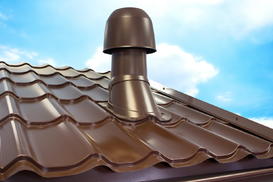Roof ventilation: tasks to be solved and device

The roof of any home is a structure that creates ideal conditions for the generation of condensate. There is both air containing water in a gaseous state, and heat rising from the premises and, finally, cold, which is outside at night or around the clock in winter. When all these three factors “meet”, the so-called dew point is obtained. The result of its action is the transition of water from a gaseous state to a liquid – it falls out in the form of drops on a cooled surface.
If the roof is not insulated, that is, non-residential, then the condensate “spoils” both the roofing material and the wooden structures of the truss system. If this is an attic, then, as a rule, it is also insulated from all sides with mineral wool heat-insulating materials. When they are saturated with condensed moisture, their properties are reduced to zero. Cotton wool gets lost, rots, loses its ability to retain heat inside the house, and cold outside.
Roof ventilation tasks
To avoid all the above problems and their consequences, roof ventilation is arranged. If it is done correctly, taking into account the type of roofing material and the configuration of the roof, then the excess moisture contained in the heated room air is discharged into the atmosphere in the same gaseous state.
This problem is solved as follows. Firstly, due to the presence of an air gap between the insulation and the roofing material, the temperature on both sides of the latter is balanced. One of the three factors in the formation of the dew point has already been eliminated. Secondly, thanks to the natural circulation of air through this very ventilation, all moist air leaves slot online yang sering kasih jackpot the roof space in a timely manner. As a result, two of the three factors that are “needed” for the dew point are eliminated.
So, roof ventilation solves the following tasks:
- The temperature of the roof on both sides is equal regardless of how warm it is in the house and how cold it is outside.
- Heated moisture-containing air does not stagnate under the roofing material, but is promptly discharged into the atmosphere.
- Unfavorable conditions are created for the generation of condensate – no moisture, no temperature difference.
- The rafter system is not saturated with water and does not rot.
- The insulation does not get wet and does not lose its thermal insulation properties.
- Snow comes off the roof not when it is “hot” from the inside of the roof, but at the appropriate air temperature outside. Since the snow comes off the roof at a positive air temperature, ice and icicles do not form on it.
- In summer, when the roof is heated during the day from the sun, it is cooled at night due to ventilation. As a result, the house is not so hot at night.
All of these problems are probably familiar to those who do not have roof ventilation.
The device and principle of operation of roof ventilation
Do not be intimidated by such a huge list of tasks that roof ventilation can handle. In fact, it is not as complicated and expensive as it might seem due to its multi-functionality. Vice versa. For its arrangement, you do not need any equipment, food and other difficulties.
The first element of the roof ventilation system is the gap between the roofing material and the waterproofing, which is placed on the roof system from above. Almost any roof has this very gap by default. It is formed due to the fact that the judi slot pragmatic play crate is made for the installation of corrugated board, metal tiles, ondulin and other materials.
But by itself, this gap does not work like ventilation, because there is no entrance and exit for natural air circulation. Below, as a rule, tightly sewn soffits, on top of a ridge. For everything to work, it is necessary to provide air access from the bottom of the roof, and its exit somewhere higher. For the intake of atmospheric air, perforated soffits are equipped, and pipes for free air outlet are installed on the upper part of the roof.
As a result of the pressure difference that occurs due to the temperature and altitude difference, humidified air is promptly removed from under the roofing material into the atmosphere.
Outcome
Roof ventilation is an indispensable element of a well-built modern home. This simple and inexpensive system to set up significantly increases the service life of materials and significantly increases the comfort of the home.